INSIGHTS
The Top Live TV, OTT, and SVOD Services for Global Sports Fans
Sports video streaming services go head-to-head with live TV and on-demand heavyweights
Live sports broadcasting and viewing are shifting globally. Sports continue to be made-for-TV but increasingly are being consumed on digital platforms and devices, while competing with other live and on-demand video and entertainment options. As such, many players in the sports ecosystem – from clubs to leagues to media/broadcast partners – are planning for the future of how sports will be delivered and consumed by fans. In this spotlight, we explore which live TV services, sports streaming services, and subscription video-on-demand (SVOD) services global sports fans are currently accessing and using. We also examine what fans are willing to pay for subscriptions of live games from their favorite leagues.
Altman Solon’s 2021 Global Sports Survey, which gauged viewing and fandom among 18,000 respondents in 16 countries across North America, Europe, Latin America, and Asia, shows that sports fans globally self-report watching on average 3.5 hours of live sports per week, and 14 total hours of live TV/video per week. Countries like the U.S., the UK, Germany, and France, with more established TV and entertainment industries, have higher overall live TV/video consumption while countries in LatAm and Asia have lower overall live TV/video consumption but higher live sports consumption.
Live TV/Video and Sports Consumption Among Sports Fans
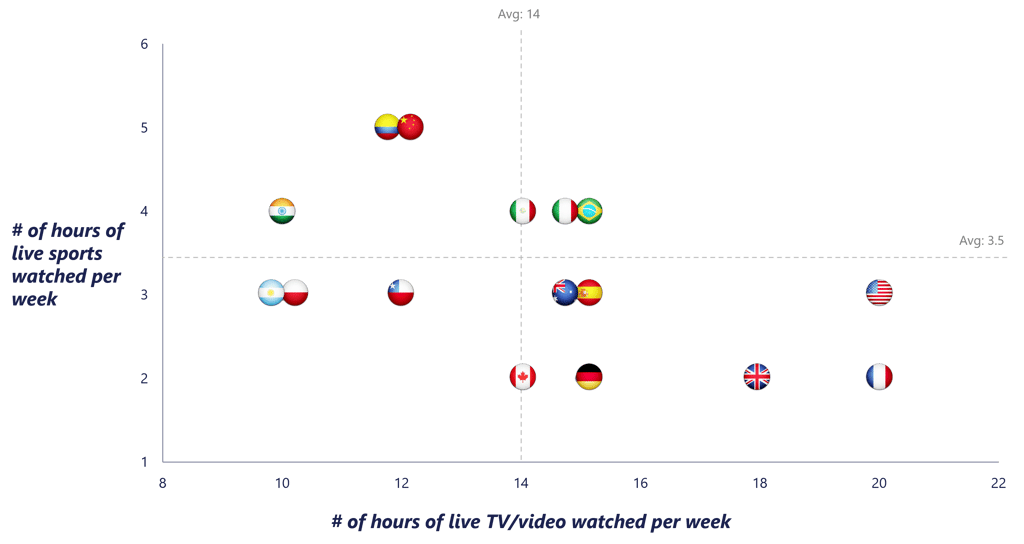
U.S. Live TV, OTT & SVOD Services
In the U.S., sports fans can access multiple services for watching live TV, sports, and on-demand entertainment. Sports streaming video services (including general services like ESPN+ and DAZN and sport-specific services like MLB.tv and NBA League Pass) compete for subscribers and viewers with both live TV services (MVPDs and vMVPDs) as well as subscription video-on-demand (SVOD) services from Netflix, Amazon, Disney, Comcast, and others.
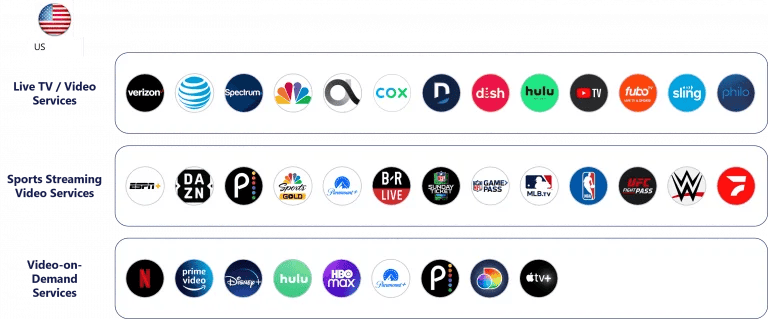
Many sports fans in the U.S. pay a monthly subscription fee for live TV service from a traditional pay TV provider (e.g., Comcast, Spectrum) or virtual MVPD (e.g., Hulu Live, YouTubeTV), which carry broadcast and cable networks (ESPN, CBS, NBC, Fox) that purchase the rights to broadcast games and events from the top U.S. and global sports leagues. As such, sports fans subscribe to pay TV at higher rates than non-fans, and most sports-focused video streaming services have lower awareness and subscribership among sports fans than pay TV and video-on-demand services.
Awareness of Live TV and Streaming Services Among Sports Fans
(% of monthly sports viewers aware of each service)

The survey shows similar levels of awareness and use of sports streaming services among sports fans in the U.S., Canada, and Mexico, all countries with relatively high live TV subscribership. The leading sports streaming service in each country has rights to the top sports in each country: American football and basketball on ESPN+, hockey on Sportsnet and Rogers in Canada, and football/soccer on Claro Sports in Mexico.
Access to Sports Video Services Among Sports Fans
(% of monthly sports viewers accessing each service)

As more sports rights are moving to streaming services (e.g., NFL Thursday Night exclusively on Amazon Prime starting next year) and more rights holders and broadcasters are shifting games from linear TV networks to OTT/streaming platforms (e.g., NBC/Peacock and ViacomCBS/Paramount+), the availability of top tier sports exclusively on pay TV in the U.S. is starting to shift.
European Live TV, OTT & SVOD Services
European markets are very different than the U.S. in terms of pay TV and Sports OTT, with European markets characterized by strong public broadcasting systems and fewer pay TV players compared to the U.S., where the sports landscape is more cable-driven. This results in high fragmentation and contrasts in pay TV penetration and higher adoption of sports streaming video services in countries like Italy, Germany, and Spain, where rights to top domestic soccer leagues are held by streaming players like DAZN.
Awareness of Live TV and Streaming Services Among Sports Fans
(% of monthly sports viewers aware of each service)
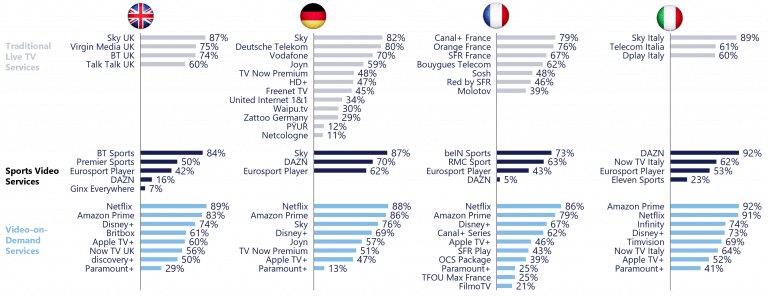
The survey also shows the value of sports rights on the ability to grow awareness and subscribership. For instance, DAZN is as well-known as Amazon Prime and Netflix amongst sports viewers in Italy where it holds rights to Serie A, the most popular league in the country. In Germany and Spain, sports viewers also have high awareness of DAZN as it holds some local rights, streaming UEFA competitions, and key foreign leagues (e.g., EPL). In other countries without Tier-1 rights, such as the U.S. or France, DAZN is less of a household name, illustrating the value of sports in building a brand and customer base.
Awareness of Netflix, Prime Video, & DAZN Among Sports Fans
(% of monthly sports viewers aware of each service)
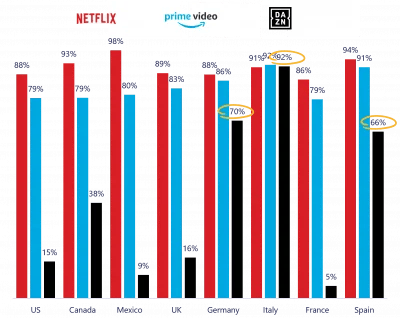
Sports League OTT Pricing Analysis
Many global sports leagues and clubs/teams are developing OTT/DTC services to offer fans (and many already have). What subscription prices are fans willing to pay to watch all the games from their favorite leagues? Based on our survey and Van Westendorp price sensitivity analysis, we found that, on average, fans think $10-15 per month is the optimal price for a subscription to all games from their favorite league. For U.S.-based fans of the top European soccer leagues, that figure jumps to $20 per month – indicating international fans’ higher willingness to pay for top global leagues, which may be more difficult to watch in foreign territories.
Optimal Monthly Price for a Subscription to All League Games
(monthly sports viewers who rated the league 7 or higher on a 0 to 10 fandom scale)
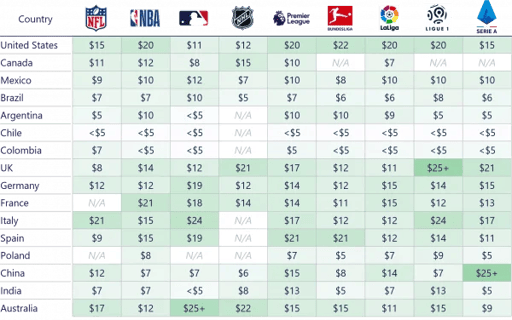
For the top U.S. leagues, with a $10-20 per month optimal price point for fans, the leagues would need to acquire tens of millions of paid subscribers to match the media rights revenues they currently generate from broadcast partners. Media organizations on the other hand manage to create higher value from rights due to their existing customer base, appeal to sports fans as potential new customers, and packaging strategies (multiple leagues being combined in a product).
Implications:
- Sports rights are key for live TV and video service providers and their investors to build audiences and generate subscribers
- Sports streaming services need top rights to differentiate their offerings and grow subscribers, but costly and hard to scale globally with varied local sports interests
- Leagues and clubs/teams need to create new digital and DTC products and services that complement traditional broadcasting revenue
- Opportunities for properties to further engage and monetize international fanbase, as fans are particularly interested and willing to pay for streaming sports content
- Teams/clubs should expand scope of offerings to include new elements (esports, betting, collectibles) and new digital/interactive experiences to increase fan willingness to pay, ARPU, engagement, loyalty
More details on drivers of sports OTT distribution and consumption, case studies, and data on willingness to pay for sports content across 16 countries can be found in Altman Solon’s Sports TV and Video report. Please submit the form below to request the report or reach out directly to one of our leaders.
Altman Solon, the world’s largest strategy consulting firm exclusively focused on Telecommunications, Media, and Technology, conducted the 2021 Global Sports Survey in August-September with more than 18,000 respondents across 16 countries. Please click here for more results from the survey.